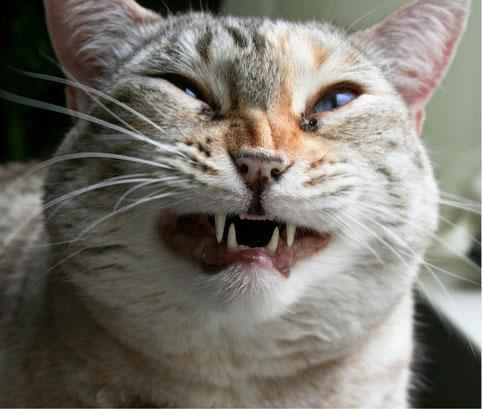Contents
Sneezing cat: should you be worried when my cat sneezes?
Just like with us humans, it can happen that a cat sneezes. It is a reflex to expel air from the body when the mucous membrane in the nose is irritated. The causes of sneezing in cats are multiple and can range from a transient banal origin to a serious illness for their health.
Why does a cat sneeze?
When a cat breathes, the air will pass through the upper respiratory tract (nasal cavities, sinuses, pharynx and larynx) and then lower (trachea and lungs). These respiratory tracts have a role of humidifying and warming the inspired air. In addition, they act as barriers to filter the air to prevent particles, such as dust, and pathogens from reaching the lungs. As soon as the mucous membrane of the respiratory tract is affected, it can no longer perform its functions properly.
Sneezing is mainly caused by a disorder of the upper respiratory tract, including inflammation of the nasal mucous membranes. It can be rhinitis, inflammation of the lining of the nose, or sinusitis, inflammation of the lining of the sinuses. If these 2 mucous membranes are concerned, we then speak of rhinosinusitis.
Other respiratory signs may be associated with these sneezes, such as a runny nose or noisy breathing. In addition, discharge from the eyes may also be present.
The causes of sneezing
There are many causes that can cause sneezing in cats. Among the pathogens involved, viruses are most often responsible.
Coryza: Feline herpes virus type 1
Coryza in cats is a syndrome responsible for clinical respiratory signs. This very contagious disease is quite often encountered in cats. It can be caused by one or more agents including a virus called feline herpes virus type 1, responsible for feline viral rhinotracheitis. Currently, this disease is one of those against which cats are vaccinated. Indeed, the consequences on the health of the cat can be serious. Symptoms include sneezing, fever, conjunctivitis, and discharge from the nose and eyes. It is important to know that when a cat has caught this virus, although the clinical signs may go away with treatment, it is possible that they will keep it for life. This virus can remain inactive but reactivate at any time, for example when the cat is stressed.
Coryza: feline calicivirus
Today, vaccinated cats are also protected against the feline calicivirus, a virus also responsible for coryza. The symptoms are respiratory, like the feline herpes virus, but also present in the mouth, especially abscesses of the oral mucosa.
For these last 2 viruses, contamination is via droplets from sneezes and secretions that contain the viruses. These can then be transmitted to other cats and infect them in turn. Indirect contamination via various media (bowls, cages, etc.) is also possible.
Coryza: bacteria
Concerning coryza, the responsible pathogen can be alone (virus or bacteria) but they can also be multiple and associated. Among the main bacteria responsible, we can mention Chlamydophila cat or even Bordetella bronchiseptica.
But viruses and bacteria are not the only agents that can be responsible for sneezing, we can also cite the following causes:
- Fungi / Parasites: Inflammation of the nasal lining can also be caused by other pathogens like fungi (Cryptococcus neoformans for example) or parasites;
- Irritation by products: the nasal mucosa can be irritated in the presence of certain agents that the cat cannot tolerate such as dust from the litter box, certain products or even smoke. In addition, an allergy to a product can manifest as allergic rhinitis. It can occur when the cat is in the presence of an allergen that his body cannot tolerate. It can be an allergen present in your home or outside such as pollen for example. In the previous case, the rhinitis is then seasonal;
- Foreign body: when a foreign body has entered your cat’s nose, such as a blade of grass for example, the body will try to expel it by sneezing more or less;
- Mass: a mass, whether tumor or benign (nasopharyngeal polyp), can represent an obstacle to the passage of air and thus cause sneezing in cats;
- Cleft palate: this is a cleft that forms at the level of the palate. It can be congenital, that is to say it is present from the birth of the cat, or it can appear following an accident. This slit then forms a communication between the mouth and the nasal cavity. Food can thus pass through this slit, end up in the nose and be the cause of sneezing in the cat which tries to expel it.
What to do if you sneeze
In the event of a transient sneezing, it may be dust that has irritated the mucous membrane, as is also the case with us. On the other hand, as soon as the sneezing is frequent or does not stop, it is necessary to contact your veterinarian for a consultation. Only he can determine the cause and prescribe an appropriate treatment. Indeed, the treatment will be different depending on the cause of the sneezing. Also remember to report any other symptoms to your veterinarian (discharge, cough, etc.).
In addition, it is important not to give human medicines to your cat. Not only could they be toxic to them, they also might not be effective.
Anyway, the best prevention is vaccination, to keep updated regularly to protect your cat against these respiratory diseases which can be serious. It is therefore important to keep your cat’s vaccines up to date by making his annual vaccination visit to your veterinarian.










